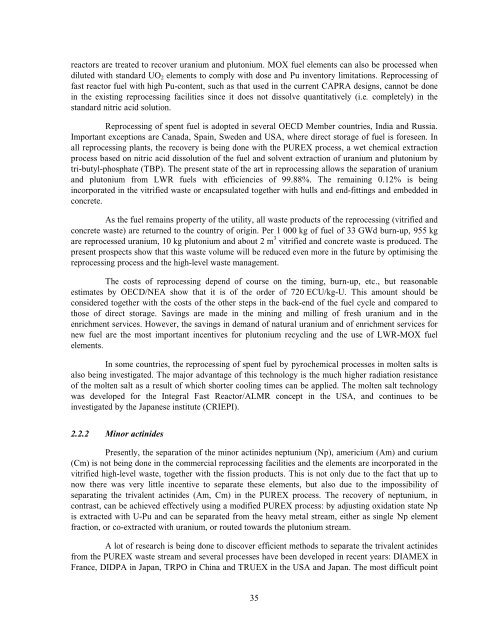COMPLETE DOCUMENT (1862 kb) - OECD Nuclear Energy Agency
COMPLETE DOCUMENT (1862 kb) - OECD Nuclear Energy Agency
COMPLETE DOCUMENT (1862 kb) - OECD Nuclear Energy Agency
Create successful ePaper yourself
Turn your PDF publications into a flip-book with our unique Google optimized e-Paper software.
eactors are treated to recover uranium and plutonium. MOX fuel elements can also be processed when<br />
diluted with standard UO 2 elements to comply with dose and Pu inventory limitations. Reprocessing of<br />
fast reactor fuel with high Pu-content, such as that used in the current CAPRA designs, cannot be done<br />
in the existing reprocessing facilities since it does not dissolve quantitatively (i.e. completely) in the<br />
standard nitric acid solution.<br />
Reprocessing of spent fuel is adopted in several <strong>OECD</strong> Member countries, India and Russia.<br />
Important exceptions are Canada, Spain, Sweden and USA, where direct storage of fuel is foreseen. In<br />
all reprocessing plants, the recovery is being done with the PUREX process, a wet chemical extraction<br />
process based on nitric acid dissolution of the fuel and solvent extraction of uranium and plutonium by<br />
tri-butyl-phosphate (TBP). The present state of the art in reprocessing allows the separation of uranium<br />
and plutonium from LWR fuels with efficiencies of 99.88%. The remaining 0.12% is being<br />
incorporated in the vitrified waste or encapsulated together with hulls and end-fittings and embedded in<br />
concrete.<br />
As the fuel remains property of the utility, all waste products of the reprocessing (vitrified and<br />
concrete waste) are returned to the country of origin. Per 1 000 kg of fuel of 33 GWd burn-up, 955 kg<br />
are reprocessed uranium, 10 kg plutonium and about 2 m 3 vitrified and concrete waste is produced. The<br />
present prospects show that this waste volume will be reduced even more in the future by optimising the<br />
reprocessing process and the high-level waste management.<br />
The costs of reprocessing depend of course on the timing, burn-up, etc., but reasonable<br />
estimates by <strong>OECD</strong>/NEA show that it is of the order of 720 ECU/kg-U. This amount should be<br />
considered together with the costs of the other steps in the back-end of the fuel cycle and compared to<br />
those of direct storage. Savings are made in the mining and milling of fresh uranium and in the<br />
enrichment services. However, the savings in demand of natural uranium and of enrichment services for<br />
new fuel are the most important incentives for plutonium recycling and the use of LWR-MOX fuel<br />
elements.<br />
In some countries, the reprocessing of spent fuel by pyrochemical processes in molten salts is<br />
also being investigated. The major advantage of this technology is the much higher radiation resistance<br />
of the molten salt as a result of which shorter cooling times can be applied. The molten salt technology<br />
was developed for the Integral Fast Reactor/ALMR concept in the USA, and continues to be<br />
investigated by the Japanese institute (CRIEPI).<br />
2.2.2 Minor actinides<br />
Presently, the separation of the minor actinides neptunium (Np), americium (Am) and curium<br />
(Cm) is not being done in the commercial reprocessing facilities and the elements are incorporated in the<br />
vitrified high-level waste, together with the fission products. This is not only due to the fact that up to<br />
now there was very little incentive to separate these elements, but also due to the impossibility of<br />
separating the trivalent actinides (Am, Cm) in the PUREX process. The recovery of neptunium, in<br />
contrast, can be achieved effectively using a modified PUREX process: by adjusting oxidation state Np<br />
is extracted with U-Pu and can be separated from the heavy metal stream, either as single Np element<br />
fraction, or co-extracted with uranium, or routed towards the plutonium stream.<br />
A lot of research is being done to discover efficient methods to separate the trivalent actinides<br />
from the PUREX waste stream and several processes have been developed in recent years: DIAMEX in<br />
France, DIDPA in Japan, TRPO in China and TRUEX in the USA and Japan. The most difficult point<br />
35
















